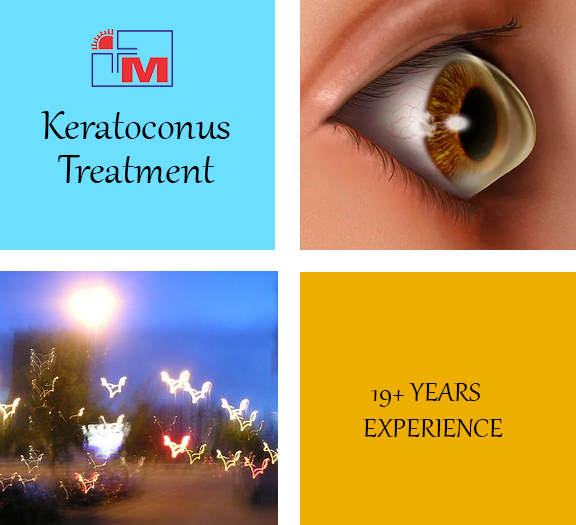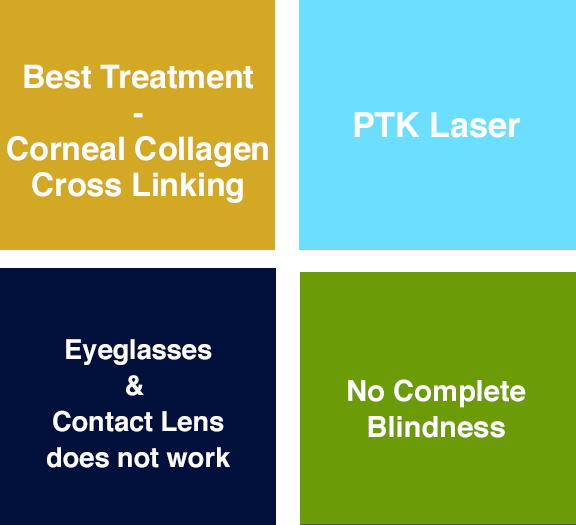
KERATOCONUS
We see through the cornea, which is the clear outer lens or "windshield" of the eye. Normally, the cornea has a dome shape, like a ball. Sometimes, however, the structure of the cornea is just not strong enough to hold this round shape and the cornea bulges outward and downward like a cone. This condition is called keratoconus
Manocha Eye Hospital caters to a significent number of Keratoconus patients every year
What causes Keratoconus?
Tiny fibers of protein in the eye called collagen help hold the cornea in place and keep it from bulging. When these fibers become weak, they cannot hold the shape and the cornea becomes progressively more cone shaped.
Keratoconus is caused by a decrease in protective antioxidants in the cornea. The cornea cells produce damaging by-products, like exhaust from a car. Normally, antioxidants get rid of them and protect the collagen fibers. If antioxidant levels are low, the collagen weakens and the cornea bulges out.
Keratoconus is genetic, so it can run in families. If you have it and have children, it’s a good idea to have their eyes checked for it starting at age 10. The condition progresses more rapidly in people with certain medical problems, including certain allergic conditions. It could be related to chronic eye rubbing.
SYMPTOMS
- A sudden change of vision in one eye
- Double vision when looking with just one eye
- Objects both near and far looking distorted
- Bright lights looking like they have halos around them
- Lights streaking
- Seeing double or triple ghost images
- Being uncomfortable driving due to blurry vision, especially at night

How Is Keratoconus Diagnosed?
Keratoconus changes vision in two ways:
- As the cornea changes from a ball shape to a cone shape, the smooth surface becomes distorted. This is called irregular astigmatism.
- As the front of the cornea expands, vision becomes more nearsighted. That is only up close objects can be seen clearly. Anything too far away will look like a blur.
What is the treatment
Treatment usually starts with new eyeglasses. If eyeglasses don't provide adequate vision, then contact lenses, usually rigid gas permeable or scleral contact lenses, may be recommended. With mild cases, new eyeglasses can usually make vision clear again. Eventually, though, it will probably be necessary to use contact lenses or seek other treatments to strengthen the cornea and improve vision.
A treatment called cornea collagen crosslinking is often effective to help prevent worsening. Intacs are implants that are placed under the surface of the cornea to reduce the cone shape and improve vision.
A specialized laser procedure called PTK can smooth out a raised scar (like a callus) and improve contact lens comfort.
If eyeglasses and contact lenses no longer provide stable and comfortable good quality vision, a cornea transplant can be performed. This involves removing the center of the cornea and replacing it with a donor cornea that is stitched into place. This is typically only done as a last resort.
Myths / Frequently Asked Questions
To say that RGP contact lenses somehow stop keratoconus from progressing is like saying that wearing a baseball hat stops a child's skull from growing. Because keratoconus is a progressive disease, there must be some medical intervention to stop it, such as corneal crosslinking.
They are referred to as "prescription inserts" because they are available by prescription only, meaning that they must be ordered and inserted by a trained surgeon. The Intacs themselves have no prescription and are not intended to provide vision correction.
In cases where patients have a very slight prescription, the need for glasses and/or contacts can be eliminated; however, we tell patients not to expect this as a result. What you can expect is a much easier time being fitted for glasses and contacts, and also possibly a wider variety of contact lens types to choose from.
Corneal hydrops (extensive scarring) as well as contact lens intolerance can occur as the disease progresses. This can lead to legal blindness and will eventually lead to the need for a cornea transplant.
